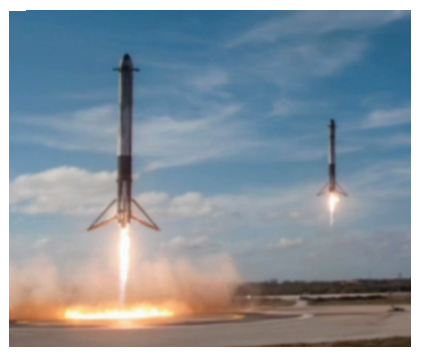This photo (below) is something that many of you may have seen online. This is February 2018, the launch and landing of the Falcon Heavy by Elon Musk’s SpaceX. Now, anyone who saw this no doubt thought it was cool, but if you don’t know the background to this, you don’t know how cool this really was. Because in 2010, President Obama put together a blue-ribbon committee headed up by my old boss Norm Augustine, the CEO of Lockheed Martin, to evaluate whether George W. Bush’s moon initiative was possible within acceptable cost limits. They concluded that it was not. According to them, development of a heavy lift vehicle would take at least 12 years and cost at least, wait for it, $36 billion. Now Musk has done it in six years at a cost of less than $1 billion, and to cap it all, the thing is three-quarters reusable. So this launch was a shot heard round the world.

What Musk did has not merely introduced a very desirable aerospace system but also proven a principle: that it is possible for a well-led entrepreneurial team to do things in a third the time of the federal government at less than a tenth the cost — things that previously it was thought only the governments of major powers could do. And not only that, but the private sector can do things that governments could not do at all despite 60 years of trying. And with that, SpaceX has set off an international space race. You have Jeff Bezos’s Blue Origin, Richard Branson’s Virgin Galactic, and even companies not led by billionaires using their discretionary cash in order to become immortal through historic achievement. Companies started by working engineers, people with no more means than most middle-class people but who managed to get investment.
One incredible example is Rocket Lab, a New Zealand company founded by a working engineer, that mobilized $300 million in investment. They have reached orbit with a launch from New Zealand. This is not science fiction, folks. This is real stuff, and it’s really happening. New Zealand has no space program, but they’ve achieved this through the initiative of private citizens and investors. And since this race has been unleashed, it has shown that it is going to be self-driving. First of all, Musk himself, with his breakthroughs in reusability, has reduced the cost of space launch by a factor of five. The cost of space launch went down a lot from Sputnik through the Apollo landing as we became competent in the various space-flight technology and pretty much developed the whole bag of tricks during that 12 years of the initial space race.
That was done by governments in the early era. They got the job done, and they reduced the price of space launch from millions of dollars a kilogram to $10,000 a kilogram. But there it stayed for 40 years until 2009. Between 2009 and 2019, as SpaceX has entered the field, it’s fallen from $10,000 a kilogram to $2,000 a kilogram. And Musk is trying to make even that price point obsolete. He’s working on a new propulsion system, a launch system called Starship, which will be fully reusable and will knock down the cost of space launch by another factor of three. So, we’re headed toward $700 a kilogram or even $500 a kilogram. And the cheaper launch is, the more launches there are going to be. That’s elementary economics. It’s cheaper, more people will do it.
Last year, there were about a hundred satellite launches in the whole world. SpaceX got 24 of them. They got a quarter of the lot. This is one relatively small launch company compared to its competitors like United Launch Alliance, the joint operation of Boeing and Lockheed Martin. They did a quarter of the total number of launches worldwide in 2018 and, really, the majority of the world market that was open for bids. Most of the rest of those were China or Russia or other governments, so you couldn’t compete for it at all. Now, because of the lowering of launch costs, I think very quickly we’re going to see 200 or 300 satellite launches a year. That in turn will contribute to further lowering of launch costs, as the cost of launch is spread out over more launches. But also, it will contribute to the lowering of spacecraft costs, because they will be being produced in more numbers. Furthermore, the designers of spacecraft will be less conservative.
For the past half century, the prevailing wisdom among spacecraft designers is don’t use anything that hasn’t been used before; because the launch is so expensive, you don’t want to risk your whole spacecraft for a 20 percent improvement in some system. So it became like the person who won’t see any movies he hasn’t seen before. That’s not the way to get a broad education, is it? That’s where spacecraft development has been stuck since the moon landings.
But now there is another revolution that has been going on, really driven by technological developments outside the space community. That’s spacecraft miniaturization. We’re now seeing micro-spacecraft, 10-kilogram spacecraft, that can do things that previously it took a 1,000-kilogram spacecraft to do. They’re much smaller and lighter and therefore much cheaper to launch. They’re also cheaper to build. These are million-dollar spacecraft instead of hundreds of millions of dollars. And that’s another innovation which will facilitate the opening of space.
That’s just what we’ve seen so far, in the past 10 years or so. I do believe, though, that if we’re going to make space travel comparable to air travel, it will still have to get much cheaper. Air travel from here to Los Angeles is maybe $5 a kilogram, not $500 a kilogram. How do we get there? You can’t do it with 300 satellite launches a year or something like that. But reusable launch vehicles open up a new market altogether, which is surface-to-surface flight on Earth. For the past 3,000 years, people have made money on the ocean. Some have made money actually taking wealth from the ocean, for instance, by fishing or mining. But far more wealth has been developed on the ocean by using the ocean as a global low-drag medium for commerce.
The ocean connects ports across the world with less drag than is available on land. And that’s where the serious money in maritime activity has been. Well, space is a zero-drag medium connecting every point on Earth to every point. You can travel from anywhere on Earth to every other place on Earth in less than an hour if you go through space. Of course, this is unthinkable with expendable vehicles, but it becomes rational, or at least conceivable, with reusable vehicles. I’ve run the numbers.
Now, we won’t see this everywhere to everywhere. It probably is going to have to be from ports, so you can launch offshore and land offshore and not have all the noise and rockets in the city. But the Starship, if it was used as a transport of this kind, could probably be feasible with a ticket price Los Angeles to Sydney of around $20,000.
To be sure, that is more than I’ve ever paid for an airplane ticket! But that is the price of a first-class ticket from Los Angeles to Sydney right now. And all those people get is a tablecloth, a free drink, and a reclining bed. Whereas with this, you’re getting there in less than an hour instead of 15 hours, and you’re getting half an hour of zero gravity and the stars of space out your window. And now instead of hundreds of flights per year, we’re talking about the possibility of hundreds of flights every day.
If you get a bigger market like this, then you can start making spacecraft components at costs comparable to other things. A rocket engine is less complex than your car, but your car costs $20,000 or something like that. A rocket engine, you’re not going to get one for less than millions. Why? Because one is a mass production item and the other isn’t. But if you start producing rocket engines, not in ones or twos, but in thousands, tens of thousands, then they become cheaper. Same thing for all the other flight systems, and this will open up the way for orbital commerce — things like orbital research labs, even orbital manufacturing. These were demonstrated in principle on the International Space Station but could not even remotely be commercial because of the tremendous costs of the space shuttle and also the bureaucracy of the space station. But now, if you’re talking about cutting the cost of access to orbit by an order of magnitude, and furthermore that means that there’ll be private space stations, which won’t put up four years of red tape before you can fly to your experiment on it and so forth, you’re going to start seeing that kind of stuff. That’s the future we have to look forward to because we’ve finally unleashed markets and entrepreneurism in space.
This article is a transcript of Robert Zubrin’s opening remarks at a Cato Institute book forum which took place in October 2019. The full text of this transcript, which includes a response by forum participant Berin Szoka, can be found here.
Zubrin’s recent book, The Case for Space: How the Revolution in Spaceflight Opens Up a Future of Limitless Possibility, is available here.





